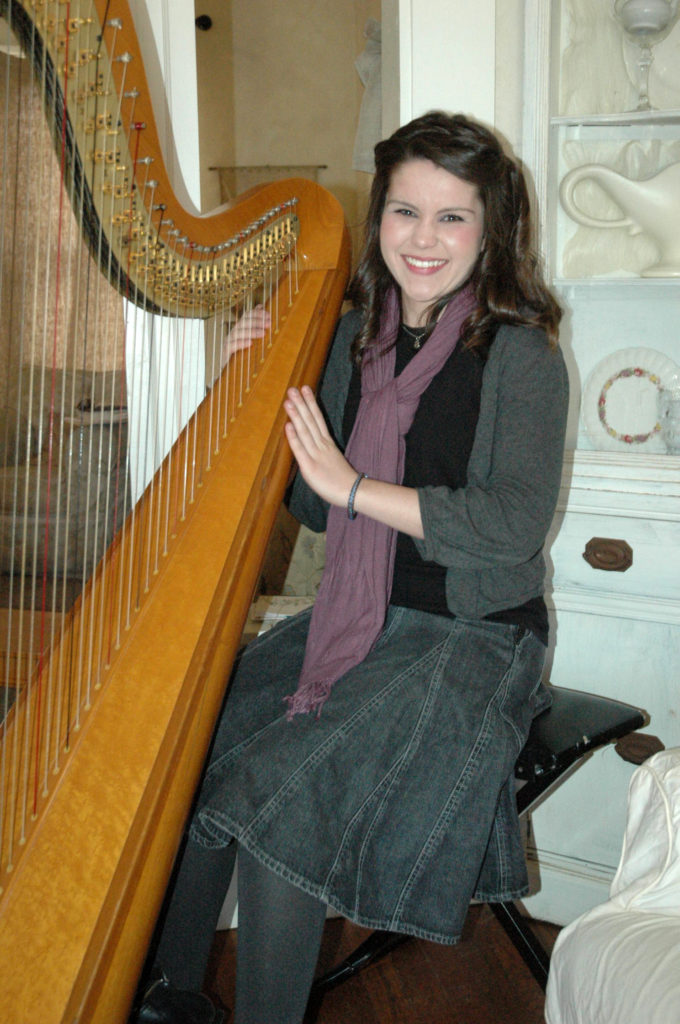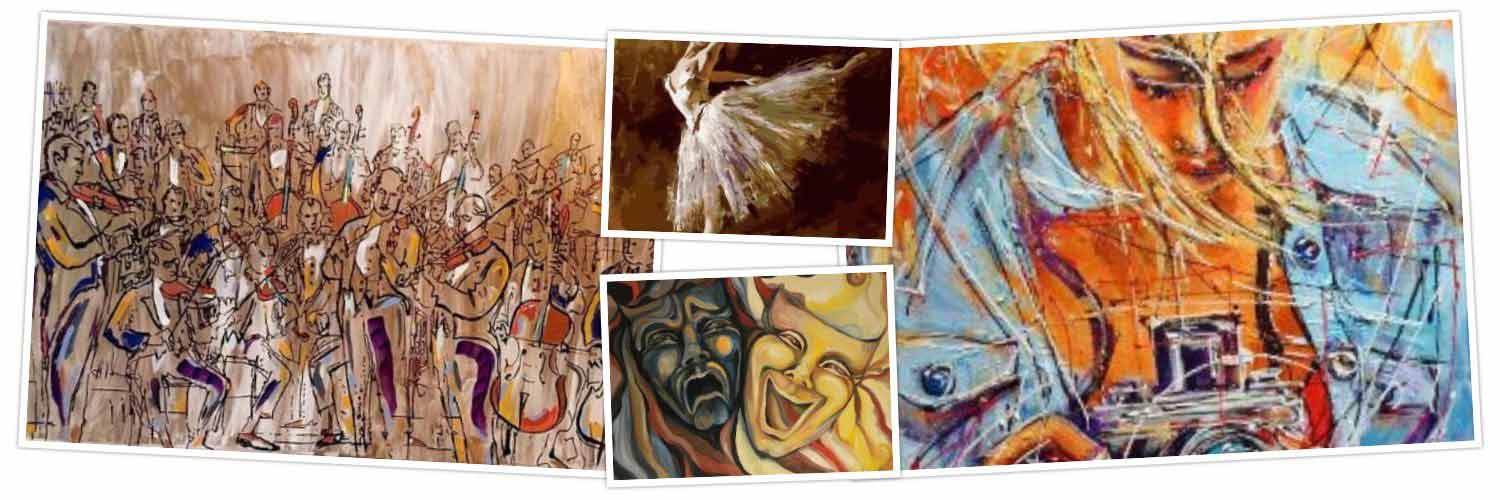Harp and Harpist in Perfect Sync
By Phil Houseal, Contributing Writer
After a two-decade-long love affair with the harp, Emily Jumes Oskins is tuning up for her first formal concert in front of her hometown audience. She will be performing for the Fredericksburg Music Club on Feb.19.
“It will be fun,” said Oskins who will be joined by her brother Collin, a voice student at Abilene Christian University. “We’ll be doing a range of styles, including classical and pops, along with some folk and Broadway. I want to share this music with my community.”
While just entering the prime of her performing career, the Central Texas resident can trace her love affair with the harp back to the precise moment it was born – when she was 4 years old. Her family took her to a concert by the Fort Worth Symphony, but their young daughter could barely see the stage from her seat in “the nosebleed section.”

“All I could see from where we were sitting was the harpist,” she recalled. “I shocked my parents by saying I wanted to play the harp.”
So, they took their young daughter to a harp teacher who offered discouraging news. At age 4, Emily’s arms weren’t long enough to reach the strings. The determined youngster was not deterred, however. “She came to us every day after that, and asked us to measure her arms, said her mother, Julie Jumes. They eventually found a harp small enough, and soon young Emily was learning to play her beloved instrument. Her dedication was evident from the beginning. Getting to a lesson was a two-hour weekly round trip. Her mom referred to herself as the “harp hauler”–a not inconsequential job for her and her husband, Michael Jumes, who homeschooled all six of their children.
When the family moved to Fredericksburg, Emily continued her studies. One of her teachers was Laurie Buchanan, a graduate of Eastman School of Music who came to San Antonio in 1961 to assume the position of principal harpist with the former San Antonio Symphony, and later taught at both Trinity University and the University of Texas at San Antonio. Buchanan immediately saw Emily was “a natural.”
“She has a very natural gift for playing it,” Buchanan said. “When you see her sitting at harp, she looks like part of the drawing, like she belongs there. Ita very natural thing for her, even as a student.”
The harp community is very small, especially in areas such as the Texas Hill country, where opportunities for performance are not as abundant as in major cities. Buchanan remembers guiding Emily during her beginnings to perform in public. ““She was pretty much on her own, by herself, in her area, so she was isolated,” Buchanan said. “But people wanted her to perform, so we had some challenges early on: things you normally learn in a semester she was asked to learn in several weeks.”
One memory was playing harp for a school production of Carousel.
“It had a big harp part,” Buchanan said. “We sweated blood over that. But she pulled it off. I was amazed, and so proud of her.”
And Emily continued to impress those in a position to know. She was one of the few students who was accepted into the Symphony of the Hills as a new student at Schreiner University, according to Eugene Dowdy, DMA, Director of Music at Schreiner University, and Conductor & Artistic Director of Symphony of the Hills.

“When Emily made it into the symphony, I encouraged our symphony harpist, Shana Norton, to act as a mentor for her, which she enthusiastically took on,” Dowdy said. “Shana would share symphony parts with Emily, and they even teamed up for a beautiful symphony harp duo at a couple of our children’s concert. Emily really grew as a professional harpist during that time. We are proud that Emily was a Schreiner student in the symphony, and very impressed with her continued professional accomplishments.”
As Emily’s ability grew, she needed an instrument compatible with her skills. For most of her early performances, Emily was still playing her Salvi Angelica Chamber harp, the first “real’ instrument she acquired. While adequate, it was not up to the demands of a professional stage. As it turned out, a beautiful instrument found her. It was a Lyon & Healy Style 22 Gold Semi-Grand harp, given to Emily by another teacher, Dr. Charlotte Marrow, who played it at Juilliard and was an instructor at Schreiner University and a member of the Symphony of the Hills. Marrow had been the only owner of that precious harp.
“She wanted her harp to be used in the Texas Hill Country,” Emily said. “I thought it was fitting that this 1927 harp with such a history would continue to be a part of our culture.”
The gift was a mixed blessing, however. The harp was showing wear from almost a century of use. Most concerning was a crack that threatened to compromise its structure. With help from the community, her family raised $15,000 to ship it back to the instrument manufacturer, Lyon & Healy Harps, in Chicago where it underwent six months of repair and refinishing. When it arrived in Chicago, Stephen Fritzmann, a master harp maker at the company, was impressed with the instrument, which features hand-carved wood and 24-carat gold leaf. He saw his goal as nothing less than “saving the soul” of the instrument. “It is a beautiful harp, with curly maple decorative veneer,” he said. “It is kind of cool that it has been owned by one person all its life.” He is thankful to be in a position to sustain such instruments. “We are a part of a lot of these stories. We are thankful these instruments are passed down to good caretakers like Emily, who will continue to use them and someday pass along for others to enjoy.”
Fritzmann understands the almost magical appeal the harp holds. “There is always interest in the harp, simply because it is one of man’s oldest instruments,” he said. “It is also one of the instruments you can pick up and it literally grabs you so you can’t put it down. It is the ‘Pied Piper’ of instruments.”
Today, Emily Jumes Oskins is a married woman and a mother, but remains devoted to her harp, which she believes may very well be one of the first man-made musical instruments, depicted in the earliest works of art and with deep roots in Irish and Celtic music. While the concept of making music with a harp might have originated with the “twang” of an early hunter’s bow, the instrument itself has since evolved with added strings, pedals, and a more sophisticated sound box to increase resonance and soften the brassy tone. Aside from the strings and wood, Emily considers it a “very therapeutic instrument.”
“That is the case whether I am listening to someone else playing it or I’m playing for my own enjoyment,” she said. “The harp has a powerful, yet soft, sound, that is able to pierce through emotions and speak life to people. I love that about it. It’s hard to make it sound bad.”
Playing for therapy is part of Emily’s mission as well. She often takes her harp to nursing homes, and used to make regular visits to a 96-year-old neighbor. “I enjoy playing at nursing homes,” she said. “That is one of my favorite things, and people are so receptive there. I enjoy ministering to elderly people with the harp. I play, and they sing.”
There is science behind it, as the harp is utilized in hospitals, nursing homes, and by sickbeds. Her teacher, Laurie Buchanan, participated in studies where she played the harp in operating rooms during surgery. The benefits of harp music were documented, even in instances when surgeons were able to revive patients by reestablishing a heartbeat that matched the tempo of the music being played. While not experiencing anything that dramatic, Emily does confirm that listening to–and playing–the harp is “life changing.” She often gets “in a zone” and really start playing for the sheer pleasure of it. “No one is listening, so there is no pressure. I can just enjoy it. Those are some of the best times. But that’s not to say I don’t also enjoy performing. “It is glorious,” she added.
——————————————————————————————————————
Emily Jumes Oskins will perform a harp concert for the Fredericksburg Music Club on Sunday, February 19, 3:00 p.m., at Fredericksburg United Methodist Church, 1800 North Llano Street, Fredericksburg, TX 78624. Donations at the door. www.fredericksburgmusicclub.com
Emily Jumes Oskins’ Studio, Harp of the Hills, is in Kyle, Texas; www.harpofthehills.com
——————————————————————————————————-

Fascinating! Long ago, I heard a concert at Rice University in Houston featuring
a harp and an electric guitar. They sounded wonderful together. Thanks to Mr.
Houseal for sharing this in-depth piece. ML